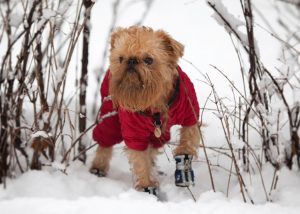With the wind gusting, snow falling and thermometer plunging, conscientious dog owners are making certain that their precious pets remain snuggly safe and warm this winter.
Keep all dogs indoors, preferably in warm “go to” places away from drafts. To ensure their skin and coat are protected against the drier air – inside and out — brush them more often than usual. Pay special attention to both elderly and arthritic dogs, as their joints may stiffen in the cold, making their movements more awkward and painful.

If you have a wood-burning fireplace and light a fire, ensure that your dog is a safe distance from the heat, flames and flying embers. This reduces the risk of singed fur, hair, paws and tails. The same applies to space heaters, except that, in this case, a dog can knock over the heater itself, possibly causing a fire.
Weather permitting, the happiest, healthiest dogs are those being walked and exercised on a regular basis. But before going outside, dress your dog — particularly seniors and smaller breeds – in a heavy sweater or coat. The colder the temperature, the greater the protection and should include waterproof, padded parkas with hoods and dog booties.

Always keep your dog on a leash, whether you’re on a city street or a country road near a frozen pond or lake. There’s nothing more dangerous or frightening than a dog running loose in the snow, possibly losing all sense of direction, or falling through the ice into the water.
When it’s cold and snowy, many dogs will resist pottying outside. Ensure that they’re warmly, but comfortably dressed, and stand close to them, perhaps with an opened umbrella to shield them and keep them dry.
Dogs lose most of their body heat from the pads of their feet, their ears, and their respiratory tract. Monitor them closely for any signs of discomfort. If they begin to shiver or whine, appear anxious, slow down or stop moving altogether, it’s time to go back inside. Be on guard as well for two more serious conditions: frostbite and hypothermia.
Once indoors, dry your dog thoroughly, paying special attention to their paws and the pads of their feet. Licking at any salt and antifreeze coating their pads can make them sick, while the combination of ice and salt can cause their pads to crack and bleed.
Never leave your dog alone in a car for any length of time on a cold day. Cars are like giant refrigerators on wheels. The only safe place for your dog on a cold day is a warm home.
Article by Nomi Berger

